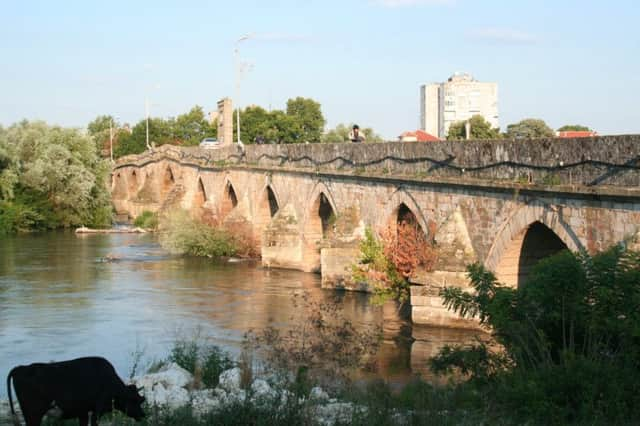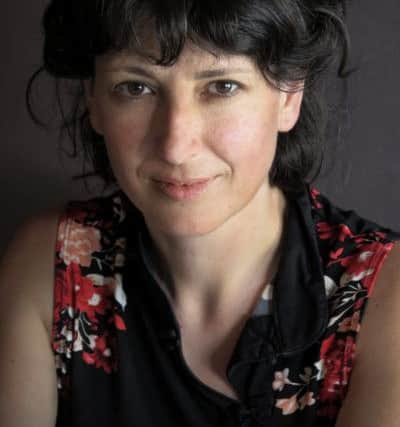Spanning the centuries: the trade in silk, wool and tobacco


Would the vizier allow the sultan to take credit for the bridge, in exchange for 400 bags of gold coins, the cost of the construction? Mustafa Pasha asked for a night of reflection. Faced with an impossible choice – disown his life’s work or disobey his master – during the night, he took poison. In the morning, the furious sultan cursed the bridge. Anyone who passed over it, he said, would lose the thing most precious to them. And his army paddled across the river, snubbing the bridge. It was a costly snub: the sultan’s two precious pages drowned in the crossing.
For a while, no one dared use the bridge. Then, one day, Mustafa Pasha’s old father was seen making his way over it. He had already lost the thing most precious to him. His symbolic act lifted the curse, and from that moment on, the bridge lent its back to tons of silk, wool, tobacco, rose oil, and everything else the empire ate and smoked, bought and sold between Budapest and Mosul. It served tradesmen, soldiers, wandering dervishes, envoys, pilgrims, bandits, travelling hippies and lorry drivers.
Advertisement
Hide AdThe tale of the bridge, the vizier, and the curse is just that – a tale – but the fact is that, because of the bridge, the Roman road went out of use. Until the early 1900s, when it was renamed Svilengrad or Silk Town, Mustafa Pasha was the name of the bridge and the town, because the town was the bridge. First, of course, there sprang up a caravanserai inn by the bridge that slept and fed untold numbers of travellers and their camels and horses. You could cook on one of the 300 fireplaces inside the courtyard, and tie your horse next to where you slept, with the saddle as your pillow and your money tied in a bundle underneath. And if you were gripped by a sudden urge to stay on and become a student of Islam, you could eat for free and even get a daily allowance.


Around the caravanserai grew a mosque, a hammam, a school, an orphanage, and a commercial district. For a long time, Mustafa Pasha was described in traveller chronicles as a chaotic market where everything was for sale. But especially some things: silk which rivalled the best in the empire; “the best watermelons in the Levant”, as a French aristocrat noted; “frivolous women of the tribe of the wretched nation that in France they usually call ‘Égyptiens’,” in the words of an Austrian traveller; and wine made from the small aromatic Muscat grapes.
Wine was the domain of the bibulous Christians – Greeks, Bulgarians, and Armenians – though Western travellers were divided on the pleasures of inebriation. The 17th century English traveller John Burbery waxed lyrical about the wine, but with the advent of Victorian puritanism, disapproval crept in, and two rather dull British diplomats wrote in 1860 of the “morally and physically degraded” Christian peasants of the area who “idly lie dead drunk upon a dung-heap”! Austrian and French travellers described the customs of locals who carried out their rituals right beside the bridge. Local Muslims frequented a Sufi saint’s tomb studded with deer horns, where “lots of dervishes and holy men came” and they spent the night on sheepskins by the tomb. The local Bulgarians had a habit of slaughtering sacrificially anointed rams on stone slabs under certain trees in kurbans reminiscent of ancient sacrifices.
Although for centuries it fulfilled its colourful destiny as a cross-roads, in the wake of the Balkan Wars, Svilengrad suffered the fate of borderlands – it was sacked and burnt, in this case by retreating Turks. Those who didn’t die fled – both Muslims and Christians – but first they buried their treasures under their houses and inside garden wells. Some returned to find their houses gone, but at least the set of fine china was still inside the well. Others (the Muslims) never came back, and new refugees from Aegean Greece moved into their empty houses.
Silk Town drew me in the first place for two reasons: because of its silky name, and because it had been one of those unvisitable places in the barbed grip of the Klyon when I was growing up.


The caravanserai was long gone, the mosque was a church, the hammam an art gallery, and the communist-era silk factories lay gutted. Instead of production, Silk Town had consumption. Instead of the centuries-long trade in watermelons, sesame-butter, cotton, tobacco, figs, and silk, now there were services. All kinds of services.One road into town was lined with today’s caravanserais – the hotel–casinos. Ali Baba, Pegasus, Monte Carlo, and Pasha all promised “Shows, cash prizes and many more surprises!”
Advertisement
Hide AdAnother road was home to a refugee camp that promised nothing.
These were once the buildings of the border army.
A third road led to a hill called Hissar, or Fortress, where treasure hunters from three countries buzzed with metal detectors over bumps that contained thousands of human years.
Advertisement
Hide AdAnd just behind Silk Town are the low-lying karst hills of Sakar, a natural continuation of Strandja to the east: a realm just as riddled with antique tombs, subterranean passages, sanctuaries, and mystical theories of a Swiss-cheese nature.
A sanctuary recently excavated by archaeologists threw up artefacts dating back not 3,000 years, as had been thought, but 6,000. The local museum director confided that treasure hunters had come to her with mind-boggling finds, but the museum had no budget to buy them.
“This Turk came once,” she said. “A treasure hunter. He had nothing to sell, but!”
But he had a tale to tell. There’s a rock niche nearby, he told her, deeply hewn into the rock face. A treasure hunter in Athens had told him about it and they had travelled here together to look for it because it was said to contain a hoard of ancient gold-crafted jewels. They had found it. Steps cut in the rock led up to it and the Turk, picking up a bad vibe, had waitedat the bottom while his Greek colleague had climbed up. The Greek didn’t come out for ages, and when he finally emerged, something had happened to his skin. They ran. The visitor wouldn’t say what his friend had seen inside, but he was keen to impress on the museum director that they should seal that place off because it was cursed.
When the museum director asked him to take her there, he said he was too scared.
“The thing is,” she said to me, “we know all the rock sanctuaries in the region – some Byzantine, some Thracian – and the one he described is unheard of. We’re still looking for it. But that’s what you get with Strandja-Sakar. A mystery inside an enigma.”
Border by Kapka Kassabova is out now (Granta, £9.99). It is the winner of the Stanford Dolman Travel Book of the Year Award 2018. Border was also named the Scottish Book of the Year in 2017.